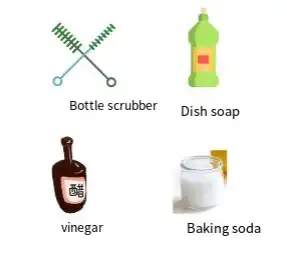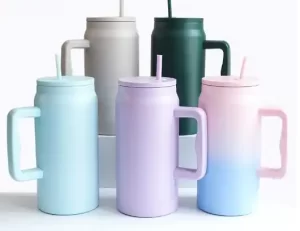Everyone has different preferences when it comes to washing water bottle at work. Some people prefer to wash their water bottle before get off work because they think it is instant and clean. Some people are willing to wash before going to work the next day, thinking that they can safely start the new day by stocking up on water.
Of course, there are also people who don’t like washing and prefer to be lazy. Especially among coffee drinkers, it has been popular for some time to leave coffee stains on their water bottle. Let’s take a look at which way of washing cups is better for our health.
So when do we wash your best water bottle?
Generally, it is best to wash your best water bottle immediately after we use them. And wash it at least once a day, either before going to work or before getting off work. Many friends prefer to wash cups before going to work because they are worried that mosquitoes or cockroaches will fly into the cup.
If it is an open cup, you can choose to finish cleaning it on the same day, take a piece of paper and turn it upside down on the paper. If it is a sealed cup, you can choose to cover it with a lid. After doing this, just take a quick shower during the day the next day.
So why do we wash the drink bottle?
Many people are unwilling to clean the drink bottle out of laziness. However, it’s a lot dirtier than you think. Drink bottle faces many crises every day.
1.Air element
Mold spores may be present in the air.
2.Water source element
Yeast may be present in the water source, and unclean or moist conditions may provide an opportunity for it to multiply. If there are cyanobacteria and green algae in the tap water pipes, they may also enter the cup through the water source.
3. Some liquids make the drink bottle “dirtier”!
Some people use drink bottle to drink water, while others use them to drink tea, cola, and coffee. But you know what? Different liquids have different numbers of bacteria growing at the same time.
Some liquids, such as milk coffee, contain some protein and can breed bacteria faster. This means that they may make the cup microbiologically “dirtier”.
Which drinks have the most bacteria after drinking?
A Japanese experiment took the following six commonly consumed beverages, opened them, took a sip, and left them for 24 hours. Finally, the bacterial contents measured were different. Let’s take a look quickly.
Under the same conditions (in a room with an average temperature of 20 degrees Celsius and an average humidity of 79%), the test results of the increase in the number of bacteria in 24 hours are as follows:
Green tea: 600-490 pieces
Water: 600-1100 pcs
Barley tea: 600-3700 pieces
Coke: 6 million-2.4938 million
Pure orange juice: 6 million-2.5039 million pieces
Milk coffee: 6.00-5.1759 million pieces
But it can be seen from the above results that the bacterial content is quite high

In addition, temperature is also an important factor in bacterial growth. Within a certain range, the higher the temperature, the higher the enzyme activity in bacteria and the faster the synthesis of metabolites, which promotes bacterial growth and reproduction.
All in all, water glasses are much dirtier than you think. A seemingly clean water glass may harbor dirt and become a breeding ground for bacteria. So thermos cups, glass cups, plastic cups, ceramic cups, no matter what kind of cup, if they are not cleaned, they will only get dirtier.
It’s normal to have different preferences. Do you know how to wash travel water bottle to be healthier?
We had an article earlier that specifically wrote about how to wash travel water bottle. Here we will briefly explain how to wash travel water bottle. If you want to know how to clean it in detail, you can click on the previous article.
1. Scrub with brush
When many people wash travel water bottle, they only rinse them lightly. Even if they wash them carefully, they only focus on the rim of the cup and ignore the wall and bottom of the cup. This actually allows some bacteria to remain. If these areas are difficult to wash, you can use a brush. Especially for stubborn stains, such as coffee stains, you can apply toothpaste on the brush and brush back and forth until it is clean.
2. Clean with dish soap
Sometimes the brush may not be able to reach some corners. In this case, washing with dish soap is a good choice. However, please note that dish soap is a chemical compound and must be rinsed thoroughly, otherwise it will be harmful to health.
3. Clean with soda water
If you run out of dish soap at home, you can wash it with soda water & warm water. When the travel water bottle is heavily stained or has a strong odor, it is recommended to sprinkle baking soda directly into the cup and then rinse it clean.
4. Clean with vinegar
White vinegar mixed with warm water can also be used to clean cups, deodorize and disinfect them.
Pay attention for the 4 plastic cups that were not washed for a week. Plastic cups with sliding lids have the most bacteria, plastic cups with push-type lids have the second highest number of bacteria, rotating lids have the third highest number of bacteria, and cups with straw lids have the least bacteria. But surprisingly, they all contain a lot of bacteria, and bacteria usually gather in the water outlet and bottle cap. Therefore, cleaning these places is particularly important.


I believe you all have the answer in your mind, when to wash and why to wash. For the sake of your own health, everyone, please take action now.





